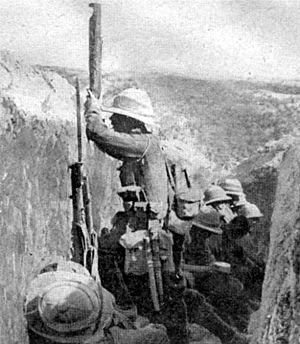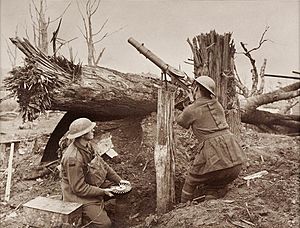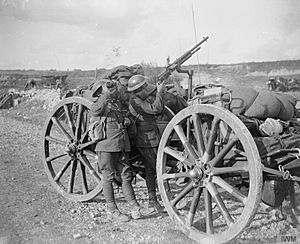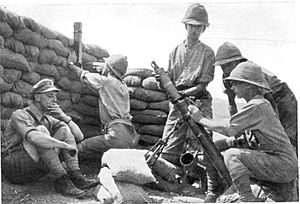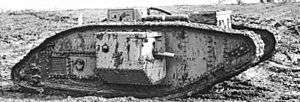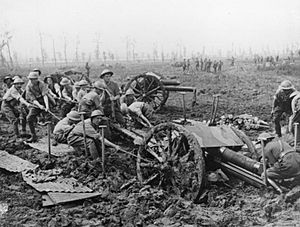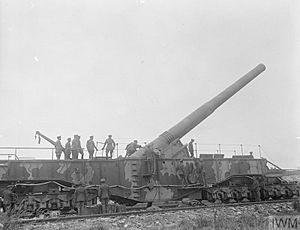British Army uniform and equipment in World War I facts for kids
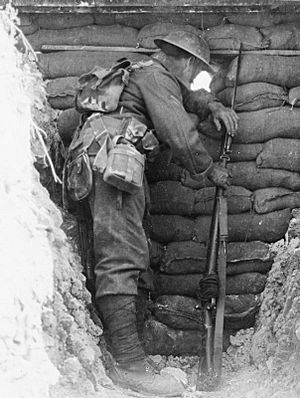
During World War I, the British Army used many different uniforms and weapons. In 1914, the British Army was known for being well-trained and well-equipped. They had already started using drab (dull, earthy) colored uniforms, like Khaki drill, for fighting in other parts of the world. After the Second Boer War, they chose a darker khaki uniform in 1902 for soldiers in Britain. This was a smart move, as other armies, like the French, still wore bright blue coats and red trousers, which made them easy targets. British soldiers were given the 1908 Pattern Webbing to carry their gear and were armed with the Short Magazine Lee–Enfield rifle.
Contents
Uniforms and Gear
Soldier's Clothing
When British soldiers went to war in August 1914, they wore the 1902 Pattern Service Dress. This was a thick woollen uniform, dyed khaki (a brownish-green color). The tunic (jacket) had two chest pockets for personal items and a pay book. It also had smaller pockets and a hidden pocket for a First Field Dressing (a type of bandage). Patches were sewn on the shoulders to protect the uniform from the rifle and equipment. Soldiers also wore stiff caps made of the same material. Puttees (strips of cloth) were wrapped around their ankles and calves, and ammunition boots with hobnail soles (metal studs) were worn on their feet.
Warm Weather Uniforms
For warmer places like India, soldiers had lighter uniforms called Khaki drill. These were made from a thinner, lighter-colored fabric.
Scottish Uniforms
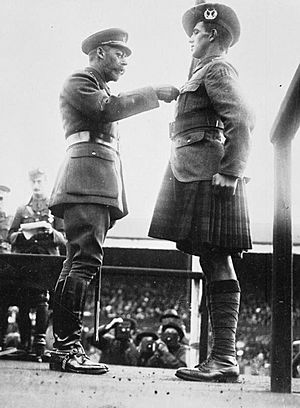
Soldiers from Highland regiments wore a slightly different uniform. Their tunics were cut to look like traditional Highland dress, allowing for a sporran (a pouch worn with a kilt). However, in battle, a khaki apron covered their kilt and had pockets, as sporrans were not worn in the field. Scottish units first wore the Glengarry bonnet but later switched to the Balmoral bonnet in 1915 because it was more practical.
Personal Equipment
1908 Pattern Webbing
The British Army was the first in Europe to use webbing instead of leather for carrying gear. Webbing is a strong material made from woven cotton. The 1908 Pattern Webbing included a wide belt, pouches for ammunition (each holding 75 rounds), shoulder straps, a holder for a bayonet, and a carrier for a water bottle. Soldiers also carried a small haversack (bag) for personal items and food, and a large pack for their Greatcoat (heavy overcoat) or a blanket. A full set of this equipment could weigh over 70 pounds (32 kg).
Older Leather Gear
An older leather equipment set, called the 1903 Bandolier Equipment, was used at the start of the war. It had five pouches for ammunition worn over one shoulder. This gear was not great for infantry (foot soldiers) but was used by cavalry (mounted soldiers) and other troops on horseback throughout the war.
When the war began, there wasn't enough webbing being made. So, a leather version of the 1908 equipment was created in 1914. This leather gear was meant for training or home use, but sometimes soldiers went to the front lines still wearing it.
Helmets
Pith Helmet
The Pith helmet was a light helmet made of cork or pith, covered with cloth. It was designed to protect soldiers from the sun. British Empire troops fighting in hot places like the Middle East and Africa wore these helmets.
Brodie Helmet
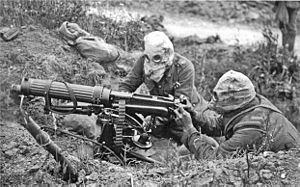
In 1915, the British Army started using the Brodie helmet, a steel helmet for protection. At first, there weren't enough for everyone, so they were kept in the front lines for soldiers to share. By mid-1916, over a million helmets had been made, and they were given to all soldiers. The helmet helped reduce injuries. Later, an improved Mark I model was made with a better rim, lining, and a dull, non-shiny paint finish.
Gas Helmets
When poison gas was first used by the Germans in April 1915, soldiers initially used cotton pads for protection. Soon, the British developed the Hypo helmet, a chemical-soaked fabric mask that covered the whole head and protected the eyes. Later, the PH helmet was introduced, which had two eyepieces. By 1916, the Small box respirator became the standard. This was a mask connected by a hose to a tin can filled with materials that absorbed the gas.
Weapons Used
Revolvers
The main handgun for British troops during World War I was the Webley Revolver. The Webley Mk VI, adopted in 1915, was very strong and reliable, perfect for the muddy conditions of trench warfare. Officers, airmen, and tank crews often carried it. Special attachments were even made for it, like a bayonet or a stock to turn it into a small rifle.
Rifles

Lee-Enfield Rifle
The Lee–Enfield rifle, specifically the SMLE Mk III, was introduced in 1907. It was known for its fast bolt-action and large magazine, allowing a trained soldier to fire 20 to 30 accurate shots per minute. This made it the fastest military bolt-action rifle at the time. German soldiers sometimes thought they were facing machine guns when they were actually being fired upon by skilled British riflemen with SMLE Mk III rifles.
Pattern 1914 Rifle
The Pattern 1914 rifle was made in the United States to help with the shortage of Lee-Enfield rifles. It was mainly used by training units and later as a sniper rifle with a telescopic sight (scope) at the front lines.
Machine Guns
Vickers Machine Gun
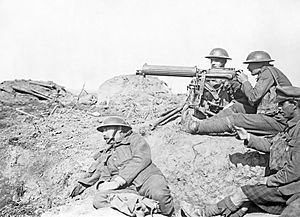
The Vickers machine gun was sent to France in 1914 and became known as one of the most reliable weapons on the battlefield. There are stories of its amazing endurance. For example, in August 1916, ten Vickers guns fired a million rounds in just twelve hours to stop a German counter-attack. They rarely broke down and just kept firing. Because of its reliability, the British Army ordered many more Vickers guns throughout the war. At first, each infantry battalion had a machine gun section. Later, the Machine Gun Corps was formed in 1915, and Vickers guns were used for support from behind the main lines.
Lewis Machine Gun
The Lewis gun was officially adopted by the British in October 1915. Even though it cost more than the Vickers gun, it was very popular because it was much lighter and quicker to build. It weighed only about 28 pounds (13 kg), which was half the weight of a typical machine gun like the Vickers. This meant a single soldier could carry and use it. The Lewis gun used drum magazines holding 47 or 97 rounds and could fire 500 to 600 rounds per minute. By the end of the war, over 50,000 Lewis Guns had been made, and they were very common on the Western Front.
Hotchkiss Mark I
The Hotchkiss "Portable" was a lighter machine gun, made in Britain but based on a French design. It was mainly given to cavalry regiments. It used 30-round metal strips for ammunition. A later version, the Mark I*, was used in tanks.
Mortars
Mortars are weapons that fire shells in a high arc, allowing them to hit targets hidden in trenches that flatter-shooting guns couldn't reach. Early in the war, it became clear that soldiers needed a weapon that could provide artillery support but was also easy to move.
2-inch Mortar
The 2-inch Medium Mortar was designed in early 1915. It fired a 42-pound (19 kg) bomb from a simple 2-inch tube. It could hit targets from 100 to 600 yards (91 to 549 meters) away. One problem was that the bomb's tail often flew back towards the soldier when it exploded.
Stokes Mortar
The 2-inch mortar was replaced by the 3-inch Stokes Mortar at the end of 1915. The Stokes Mortar was simple to make and use. It could be taken apart into three pieces for easy carrying. It could fire up to 25 bombs per minute and had a maximum range of 800 yards (732 meters). By the end of the war, British Empire units had over 1,600 Stokes mortars.
9.45-inch Mortar
The 9.45-inch Heavy Mortar, also known as the "Flying Pig," was a larger mortar introduced in 1916. It was based on a French design and fired a 150-pound (68 kg) bomb. These powerful mortars were used at a higher level of command, not by individual units.
Tanks
Mark I and Later Tanks
Trench warfare, with its trenches, barbed wire, and machine guns, made attacking very difficult and costly. There was a need for a protected vehicle that could move over rough ground, support troops, and destroy enemy machine gun nests. This led to the invention of the tank. Armored cars couldn't handle rough terrain, so new designs were needed.
The Mark I tank was the first British tank used in battle. It was developed after Winston Churchill suggested looking into a mechanical solution to the trench warfare stalemate. These tanks could travel about 23 miles (37 km) without needing more fuel and moved at 3 miles per hour (4.8 km/h). They first saw action in September 1916. Mark I tanks came in two types: 'male' and 'female'. Male tanks had two 57mm (6-pounder) guns and three machine guns. Female tanks had two heavy Vickers machine guns instead of the larger guns. Tanks continued to improve during the war, with later models like the Mark IX tank designed to carry troops or cargo.
Medium Mark A Whippet
Another tank was the Medium Mark A Whippet. While heavy tanks were for attacking trenches, the Tank Corps wanted a lighter, faster tank to work with cavalry in open areas. The Whippet had a crew of four and three Hotchkiss machine guns. It weighed 14 tons and could go over 8 miles per hour (13 km/h). Whippets first appeared during the German Spring Offensive in 1918. By the end of the war, Whippets were responsible for more German casualties than any other British tank.
Hand Grenades
At the start of the war, the main grenade was the No 1 Grenade, but it had problems. So, the Jam Tin Grenade was designed, which contained explosives and metal fragments. Later, the very successful Mills bomb was introduced in 1915. It was oval-shaped to fit in a hand and had a time fuse. The Mills bomb was a defensive grenade, but it was also used by soldiers attacking trenches. After throwing it, the user had to quickly find cover. Over 33 million Mills bombs were made in the last three years of the war.
Artillery
In 1914, the heaviest artillery gun was the 60-pounder gun. The Royal Horse Artillery used the QF 13-pounder gun, and the Royal Field Artillery used the QF 18-pounder gun. By 1918, artillery had become the most important force on the battlefield. The number of heavy and siege (large, fixed) artillery batteries grew a lot. To move these heavier guns, the army started using over a thousand Holt caterpillar tractors, which made moving big guns much easier. The army also put large naval guns on railway cars to create mobile, long-range artillery on the Western Front.
18-pounder Gun
The 18-pounder gun was the most important field gun of the war. Over 10,000 were made, and 113 million rounds of ammunition were used. Some Royal Horse Artillery units also started using it because their 13-pounders were not as good for trench warfare.
The 6-inch guns were first sent to France in 1914. They were very good at destroying enemy defenses and cutting barbed wire. This gun was used in all war zones.
60-pounder Gun
The 60-pounder guns were used in "Heavy Batteries" by the Royal Garrison Artillery. They were mainly used to destroy or silence enemy artillery. By mid-1916, these heavy batteries were increased to six guns each to provide more firepower.
Railway Guns
Some of the biggest guns used were Railway guns. There were sixteen of the smaller 9.2-inch railway guns by the end of the war. The BL 12-inch railway gun could fire an 850-pound (386 kg) shell 12 miles (19 km) into German areas. The largest railway gun was the BL 14-inch Railway Gun called Boche Buster. It fired its first shot in front of King George V and hit a railway yard 18 miles (29 km) away.
See also



